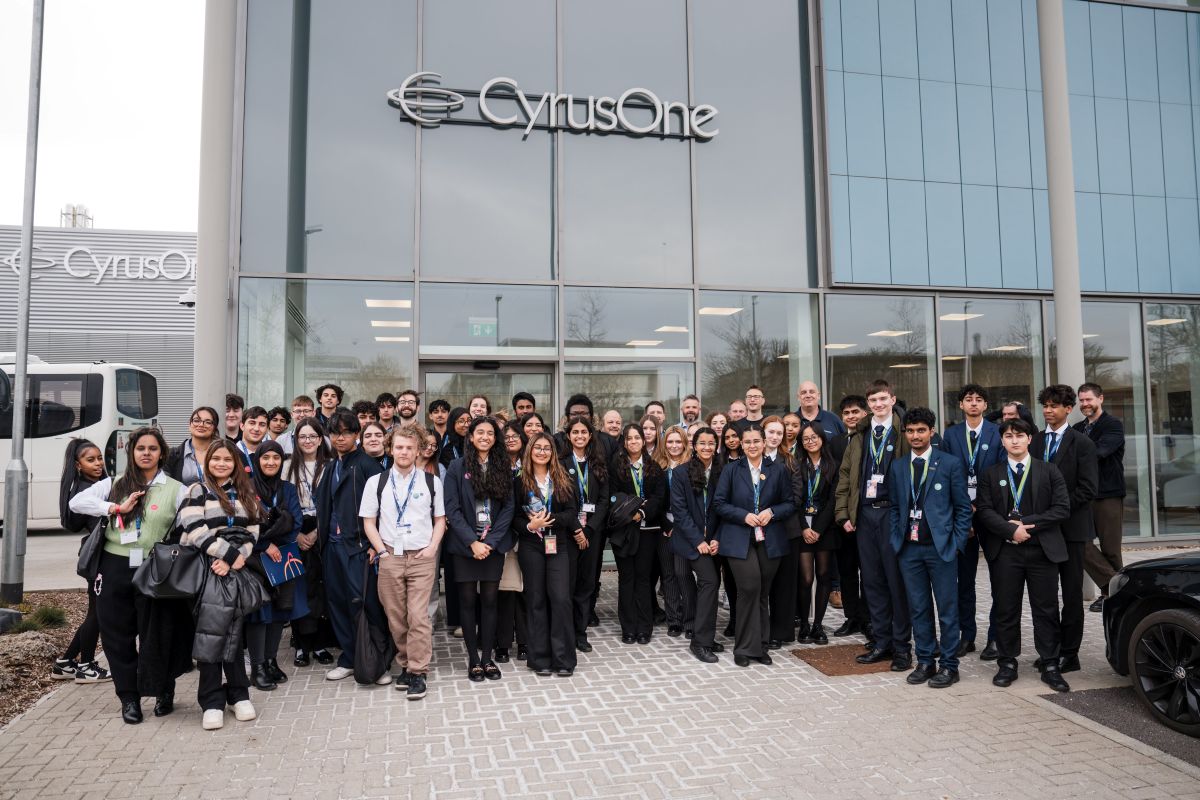Data Centre Business News and Industry Trends
Data Centres
Hyperscale Data Centres: Scale, Speed & Strategy
Insights into Data Centre Investment & Market Growth
News
Townsend Group invests in CleanArc Data Centers
CleanArc Data Centers, a developer and operator of renewables-focused hyperscale data centre campuses, announced today that Townsend Group, an advisor and partner to institutional investors globally, has made a strategic investment in the company.
The investment was led by Townsend, which advises a consortium of global investors, including some of the largest sovereign and pension plans pursuing strategic stakes in leading investment and operating platforms. This new partnership further supports CleanArc’s growth initiatives as it continues developing its first data centre campus in Virginia, set to deliver 300 MW of capacity by Q1 2027.
“We’re excited to welcome Townsend as a strategic investment partner,” says James Trout, Founder and CEO of CleanArc. “Their capital markets expertise, institutional knowledge, and private real assets scale will be instrumental as we execute on our mission to develop the data centres of the future, particularly our inaugural campus in Virginia, VA1. Townsend brings a demonstrated track record of supporting transformative businesses throughout their growth journeys. And with Snowhawk’s ongoing investment leadership, we’re well-equipped to continue tackling the growing data centre challenges faced by hyperscalers.”
“CleanArc’s strong team of industry veterans and their shrewd approach to site selection, development and power structuring really sets them apart,” adds Anthony Frammartino, CEO and Chairman, at Townsend. “We’re excited to support the company’s continued development of leading data centre campuses across Tier 1 markets.”
Snowhawk LP will remain the majority stakeholder in CleanArc as the company continues to solidify partnerships with hyperscale customers and expand infrastructure in key markets.
“Snowhawk is delighted to partner with Townsend on this strategic investment in CleanArc, further accelerating innovation and the development of capacity to support the next generation of AI and cloud capabilities,” remarks Brian McMullen, Managing Partner and Co-Founder of Snowhawk Partners.
“CleanArc continues to set new standards in future-focused data centre development,” concludes Greg Stamas, Managing Director at Snowhawk. “In partnership with Townsend and our other investors, we are excited to support CleanArc’s continued leadership in sustainability and renewable energy use.”
For more from CleanArc Data Centers, click here.
Simon Rowley - 17 April 2025
Data Centre Business News and Industry Trends
Data Centre Training & Certification Programs
Data Centres
News
HireHigher and CyrusOne drive data centre awareness
As part of HireHigher’s continued partnership with CyrusOne, a global data centre developer and operator, to address the ongoing skills shortage in the data centre industry, they recently brought together 90 sixth-form students from St Mark’s Catholic, Gunnersbury Catholic and Logic Studio Schools in West London, for the largest student-facing digital infrastructure conference in the UK.
The event was hosted by the London Heathrow Marriott Hotel ahead of today’s International Data Centre Day. It also marked three years of HireHigher and CyrusOne’s partnership to help broaden awareness of the integral role data centres play in society and the job opportunities they generate, particularly amongst the Gen Z age group.
Data centres provide the digital infrastructure that underpins almost every aspect of our daily lives, enabling a vast range of economic, scientific, and social activities. A recent independent survey commissioned by CyrusOne, titled 'Listening to Communities', explored how the public perceives data centres in Europe, and found that those aged 16-24 years were least likely to know that data centres play a role in enabling digital applications such as WhatsApp (35%).
HireHigher states that it's not surprising that today's digitally dependent generation, which represents the future workforce, is unaware of the significance of data centres in our lives. However, the company believes that this highlights the need for the industry to engage with younger generations through events such as this to help them understand the importance of data centres, their crucial role in modern society, and the impressive range of career opportunities they offer.
Adelle Desouza, Founder of HireHigher, says, “It’s a testament to CyrusOne’s commitment to attracting the best talent to the industry that they have once again joined us to host an event for sixth formers. If the industry wants to attract top talent, we need to ignite more passion in the young workforce of the future, ensuring they are well informed and inspired and understand what options there are for them in the industry.”
Emma Fryer, Director Public Policy Europe at CyrusOne, adds, “We’re delighted to have partnered with HireHigher once again to deliver an outstanding event. In-person engagement is essential if we are to forge meaningful connections with the next generation of talent and show students first hand how important, relevant and exciting our industry is. My favourite part of the day was tasking the students to design a community-oriented data centre. By encouraging our students to work collaboratively and to think about meeting the specific needs of host communities, from sustainability to social equity, we brought to life the challenges that our own teams work on every day and gave them the chance to work things out for themselves.”
With the additional support of Virtus Data Centres, the annual event forms an important part of HireHigher’s aim to improve careers advice in schools and partner with organisations that will help create real action within the industry. Events such as these help to attract new talent and contribute to the current skills shortage the industry faces in a positive way.
As part of the day’s agenda, the students heard from a panel of graduates and apprentices from CyrusOne and HireHigher’s Rising Star Programme, who discussed their jobs and routes into the industry. Students also had the opportunity to visit one of CyrusOne’s or VIRTUS’ data centres.
Vlad Tipu, Computer Science teacher at Logic School, comments, “Students have had a great opportunity to engage with professionals in a well-established sector. This will provide them with excellent perspectives and potential career paths they can pursue for their futures.”
For more from CyrusOne, click here.
Simon Rowley - 27 March 2025
Data
Data Centre Compliance: Standards, Risk & Governance
News
Arctera named a Leader in Gartner Magic Quadrant
Arctera (Veritas Technologies), a data management expert and formerly part of Veritas, has been positioned as a Leader in the inaugural Gartner Magic Quadrant for Digital Communications Governance and Archiving Solutions (DCGA). The report’s publication comes shortly after Arctera announced it will put renewed focus on its Data Compliance InfoScale and Backup Exec businesses, following its split from Veritas.
The new Gartner report covers a landscape that Arctera believes is marked by growing multichannel and AI-powered communications, which are subjecting organisations to greater regulatory scrutiny and steep penalties for violations. To mitigate data compliance risks in this evolving landscape, organisations from the most heavily regulated industries around the world rely on information governance, eDiscovery and surveillance products from Arctera. This includes more than 70% of the world’s top financial firms.
Lawrence Wong, now Chief Executive Officer at Arctera, says, “The issue of data compliance is a board-level conversation, driven by the enormous growth in data, digital and off-channel communications and the rise of generative AI. The complexity of compliance challenges is increasing and so are the stakes. Arctera understands this well. We view Arctera’s (Veritas Technologies’) position in the Gartner Magic Quadrant for DCGA as a testament to the strength of our portfolio and proven expertise in helping organisations simplify compliance.
“Our data compliance business has consistently been an industry leader. With the opportunity to put the spotlight even more on compliance within Arctera, we intend to extend our position and bring even greater value to our customers.”
Tom Lounsbury, Director of Business Development at Bluesource, notes, “When our customers are evaluating compliance solutions, they want the confidence that comes from working with a specialist like Bluesource, deploying a solution from an industry leader like Arctera. When it comes to compliance, organisations want to trust that technology is at the forefront of innovation, using the most advanced tools to ensure that they meet even the strictest of regulatory standards.”
Arctera Data Compliance offerings are available across all operational models, including on-premises, self-managed and SaaS. Visit arctera.io on 13 January 2025 to download a complimentary copy of the full Gartner Magic Quadrant for Digital Communications Governance and Archiving Solutions.
Simon Rowley - 10 January 2025
Data Centre Compliance: Standards, Risk & Governance
News
Aruba obtains certification for identity proofing innovation
Aruba, an Italian provider of cloud and data centre services, has announced that Aruba PEC – part of the Aruba Group – has obtained certification for compliance with ETSI 119 461 standards, as well as other relevant technical standards for its remote automatic identity proofing solution.
This certification proves Aruba’s compliance with European technical standards for identification services related to trust services established by the European Telecommunications Standards Institute (ETSI).
Aruba's certified identity proofing innovation, which will be officially unveiled in the coming months, enables the certain identification of applicants for the activation of trust services in accordance with eIDAS regulations. Its potential, however, goes beyond trust services with numerous use cases that integrate applicant identification processes. With the use of artificial intelligence (AI), and advanced liveness detection and face-matching algorithms, this technology can be used for applicant recognition in a range of automated onboarding processes. For example, it can be applied to situations such as the opening of a bank account or issuance of mobile phone SIM cards to optimise customer identification processes. This will enable organisations to improve their user experience, reducing verification time and ensuring the highest level of security and reliability for customers.
An additional benefit of Aruba's innovation is that it can support financial institutions in ensuring compliance with the requirements of the European Digital Operational Resilience Act (DORA) directive on digital operational resilience of financial institutions. DORA mandates the adoption of effective measures to protect digital operations from cyber threats. Aruba's fully automated, AI-based identity proofing solution meets these requirements by reducing digital onboarding risks and improving data protection for financial institutions.
For Aruba, the digital identity sector is a strategic lever in a rapidly expanding market which it is investing in decisively. These investments include internal research projects taken on by the Aruba Software Factory and ongoing collaboration with important research organisations and academic institutions such as the Polytechnic of Turin and the LINKS Foundation, to develop advanced AI solutions. These projects all work towards the goal of improving digital identification processes by developing new algorithms and ensuring the highest standards of security, reliability and ease of use.
Marco Mangiulli, CIO and Head of Software Development at Aruba, comments, “AI is opening up new opportunities for the world of trust services and digital identity. The certification of our solution to ETSI standards allows us to operate at the highest levels of security and regulatory compliance, offering flexible and innovative solutions that improve not only operational efficiency, but also digital resilience, in line with European regulations.
“Digital onboarding and identity proofing processes are crucial for the activation of numerous services, including digital identity services in Italy, such as SPID, IT Wallet and EUDI Wallet. With the support of AI and the continuous evolution of Aruba's solutions, the company is at the forefront of digital transformation and operational security in the trust services industry and beyond.”
For more from Aruba, click here.
Simon Rowley - 19 December 2024
Data Centre Business News and Industry Trends
Data Centre Training & Certification Programs
Data Centres
News
Innovorg and IDCA to transform workforce development
Innovorg, a skills-building and workforce optimisation platform for cloud, hosting, and data centre teams, announced today that it has partnered with The International Data Center Authority (IDCA), an expert in application ecosystem standardisation and education.
The partnership will integrate IDCA's comprehensive training content, certification programmes and standards into Innovorg's cutting-edge platform, creating a powerful solution for companies seeking to develop and optimise their technical workforce across the entire digital application ecosystem.
The collaboration focuses on creating adaptive learning experiences for digital infrastructure sector professionals by integrating IDCA's vendor-agnostic content and effective skill development programmes into Innovorg’s master content library, which now includes both paid and public IDCA resources alongside supplementary content.
Innovorg’s platform takes this further by automatically curating relevant IDCA content and helping prioritise the right learning materials based on individual skills gaps, company preferences, and goals. The platform sets targeted learning objectives, tracks engagement levels, and ensures alignment with personal development goals, creating a structured, personalised educational journey.
"We are excited to partner with IDCA to bring its world-class training content and industry standards to our platform," says Elya McCleave, CEO and Founder of Innovorg. "This collaboration will enable us to offer an unparalleled learning experience to our clients, combining IDCA's global expertise with our innovative skills development and workforce optimisation tools."
Kurtis Friesen, Head of North America for IDCA, adds, "Partnering with Innovorg allows us to extend our reach and impact in the industry. By leveraging Innovorg's platform, we can deliver our highly effective training content to a broader audience and help Innovorg address the critical skills shortage across the application ecosystem, including cloud, AI, blockchain, cybersecurity, IoT, big data, and data centre sectors."
In addition to content delivery, Innovorg enhances learning engagement by generating AI-based quizzes and simulations that complement IDCA’s material as needed, reinforcing comprehension and practical application. IDCA badge delivery to Innovorg clients allows for instant, globally recognisable certification, giving professionals immediate, tangible recognition for completed courses. By incorporating IDCA's global standards and best practices, Innovorg ensures that professionals are equipped with up-to-date, internationally recognised knowledge in the field of data centre infrastructure, data centre operation, data centre engineering, data centre technology, and data centre management.
This partnership comes at a crucial time for the industry, as the demand for skilled professionals across the application ecosystem continues to outpace supply. By combining IDCA's regularly updated, industry-informed content with Innovorg's advanced skills gap analysis and career pathing tools, the two organisations aim to create a comprehensive solution for workforce development in the digital infrastructure space.
Simon Rowley - 17 December 2024
Data Centres
Insights into Data Centre Investment & Market Growth
News
PolarDC secures €500m equity investment
Fiorenzo Manganiello (left) and Nessim-Sariel Gaon (right), co-founders of data centre firm, PolarDC Group, have secured capital investment from H.I.G. Infrastructure in a deal worth up to €500 million (£418m). The move signals the pair’s plans to further scale Polar and invest heavily in firms meeting the market demand for emerging technologies.
Polar develops, owns, and operates data centre infrastructure targeting high-performance computing (HPC) applications, including AI. The company has multiple data centre facilities in Norway and is actively developing additional locations across Europe. Its first data centre, located in southern Norway, will provide up to 48MW of IT capacity once fully operational.
The co-founders launched Polar in 2021 after identifying the rapidly growing demand for AI infrastructure. Anticipated debt financing of €350 million will bring the total value of the transaction to €500 million, with H.I.G. investing up to €150 million and gaining a majority stake in the company. Fiorenzo and Nessim say that they are excited to see what the future holds for Polar following this capital increase, and they look forward to working hand-in-hand with H.I.G. to further accelerate Polar's growth.
The development of AI technology is expanding the data centre market rapidly and is predicted to drive a 160% increase in power demand by 2030. The amount of computing power that AI models consume generally doubles every six months, and the demand outlook is robust, requiring data centre operators such as Polar to continue to scale accordingly. The duo plan to continue expanding the company in order to meet the growing demand and support the continuous development of innovation across the AI ecosystem.
Fiorenzo and Nessim will continue to play an essential role at Polar, retaining a minority stake through their investment firm, LIAN Group, which they also co-founded together in 2019. The pair will bring their years of expertise in digital infrastructure to support the company’s next phase of growth, remaining close to its day-to-day operations.
LIAN Group is an investment firm with over $500 million of deployed capital across technology companies in digital infrastructure, AI, healthcare, and blockchain. Through LIAN Group, Fiorenzo and Nessim build and fund cutting-edge businesses, primarily across these sectors. Its co-founders plan to double down on this strategy in the near future and beyond.
H.I.G. Capital is a leading global alternative investment firm with $65 billion of equity capital under management. H.I.G.’s infrastructure strategy focuses on making value-add and core-plus investments in the infrastructure sector. Its investment in Polar and deep sector expertise will enable the company to deliver on its near-term pipeline goals.
Nessim-Sariel Gaon, Co-Founder of Polar, says, “As AI technologies continue to strengthen their grip on the world, demand for well-equipped data centres will continue to skyrocket. We founded Polar because we envisaged that demand and wanted to be able to offer a solution that was sustainable, efficient, and scalable – we wanted to develop AI infrastructure that allowed new technologies to flourish.
“AI technologies are becoming increasingly sophisticated, with the potential to transform every sector. Its evolution requires more and more computing power, and we must be able to meet that demand. H.I.G.’s investment and experience will help accelerate Polar’s growth and pave the way for innovative HPC technologies across Europe. This is only the beginning.”
Fiorenzo Manganiello, Co-Founder of Polar, adds, “Our intention with LIAN Group has always been to build and fund cutting-edge tech businesses that meet the market demand. Nessim and I have dedicated time, energy, and passion into making Polar a significant player in the data centre space. We are ready for the next wave of AI’s development and are excited to partner with H.I.G. Its investment and operational expertise will help guide the company through this next phase of its development. Looking ahead, we’re keen to develop other market leaders like Polar. We are constantly impressed with new and emerging innovations and are eager to be a part of their journey.”
Andrew Liau, Co-Head of H.I.G. Infrastructure, remarks, “The team behind Polar has extensive experience operating and scaling data centre infrastructure; a sector H.I.G. has a strong track record in. Our combined expertise will set the stage for the company’s continued growth as it expands alongside the rising demand for data centre infrastructure. We’re incredibly excited by this partnership.”
Simon Rowley - 11 October 2024
Data Centre Business News and Industry Trends
Data Centre Training & Certification Programs
Data Centres
News
AVK to develop next generation of data centre engineers
As part of its ongoing commitment to developing the data centre industry's future talent pipeline, AVK, a supplier of power solutions for data centres in Europe, has announced the opening of its new AVK Academy.
Located in Lenham, Kent, the AVK Academy is a dedicated centre of excellence designed to provide hands-on training and professional development for engineers at all stages of their careers.
The AVK Academy is a cutting-edge training hub equipped with the latest technology, including full-size Rolls-Royce mtu engines and control system rigs. It offers practical, real-world experience in power generation, helping trainees develop the skills they need to excel in the field.
The power generation industry is evolving rapidly, with growing demands for more efficient and sustainable solutions. To meet these challenges, AVK says that it is essential to cultivate skilled professionals who can drive innovation and maintain the high standards the industry requires. The AVK Academy addresses this need by providing structured training programmes that cater to various experience levels, from complete beginners to advanced engineers looking to enhance their skills.
One of the Academy’s key features is its focus on hands-on learning. Trainees work directly with cutting-edge equipment and technology, gaining invaluable insights into the complexities of power generation. The training is comprehensive, blending classroom instruction with practical exercises that prepare participants for the diverse challenges they will face in the field. This approach not only builds technical expertise but also fosters a deeper understanding of the power generation landscape, setting the foundation for a successful career.
For new talent, the Academy offers a unique entry point into the industry. Its Level 4 intake is specifically designed for those at the beginning of their careers, providing them with foundational training and mentorship. This programme goes beyond technical skills, emphasising the importance of safety, teamwork, and problem-solving - key attributes that are highly valued in our industry. Participants receive a well-rounded education that prepares them not just for their first job but for a long-term career with opportunities for growth and advancement.
“The AVK Academy is more than just a training facility - it represents a strategic investment in the future of our company and the industry, and serves as a powerful tool for attracting new talent to the industry,” says Lynsey Partlow, Service Director, AVK. “By nurturing talent within a controlled, supportive environment, AVK is helping to build a pipeline of skilled professionals who will drive innovation in power generation while creating a clear pathway for education and career development - making the power generation field more accessible and appealing to a diverse range of aspiring professionals.”
“The AVK Academy initiative aligns with AVK's broader mission to deliver innovative and sustainable power solutions that meet the needs of the company's customers, everywhere,” adds Ben Pritchard (pictured above), CEO, AVK.” By equipping AVK's engineers with the skills and knowledge they need at a time of unprecedented industry growth, the company is strengthening its ability to provide reliable, cutting-edge services and creating a culture of continuous learning and development that permeates every level of AVK's organisation.”
Simon Rowley - 8 October 2024
Data Centre Compliance: Standards, Risk & Governance
Data Centres
News
Scalable Network Attached Solutions for Modern Infrastructure
Underinvestment blamed for IT security compliance failures
Companies are failing to achieve continuous IT security compliance because they are allowing their procurement processes to become outdated, according to new research from Vertice, a SaaS and cloud spend optimisation platform.
Vertice surveyed 300 global procurement leaders to rate their business purchasing processes across seven key areas, and to also rate their ability to maintain continuous IT compliance - and discovered a clear correlation between an organisation’s procurement maturity and the businesses’ security.
Vertice's Procurement Impact Report reveals that businesses with an optimised and automated procurement function see a 20% improvement in achieving compliance compared to those with manual and decentralised processes. Alarmingly, only one in six (18%) companies have made the necessary improvements, which include adding automated internal and external compliance checks to procurement request intake forms, along with pre-approved suppliers and intelligently adding suitable compliance stakeholders to the approval process.
Meanwhile the remaining 82% of businesses - whose procurement processes are instead manual, undefined and inconsistent - all struggle to maintain continuous IT and security compliance.
The findings also indicate that procurement leaders are struggling to control shadow IT without intelligent procurement processes in place, with 30% reporting that employees frequently bypass IT and procurement checks to adopt new suppliers. This issue is particularly prevalent in the US, where over one-third (34%) of leaders worry that maverick spending will become increasingly challenging unless their procurement functions are modernised.
Vertice’s report discovered that the US is significantly lagging behind the UK, with almost half (44%) of businesses in the lowest maturity levels, whereas two-thirds (67%) of UK businesses are in the more advanced stages of procurement maturity with more reliance on automation, AI and integrations.
Despite the significant benefits that procurement maturity brings to companies, many leaders are facing a growing number of risks and challenges when establishing high-performing procurement functions. Worryingly, 37% of respondents say that procurement is not a strategic priority versus other initiatives, and 35% say their organisation is not willing to invest in the skills to tackle the issue.
Eldar Tuvey, CEO and Founder of Vertice, says, “Procurement is an important catalyst to business compliance; the secret weapon that often goes unnoticed. Quick, intelligent, integrated processes can equip teams faster, and without compromising safety and compliance. But most procurement departments have been unable to mature their outdated, manual processes, throttling the businesses’ progress and putting compliance at risk.”
Among other benefits, Vertice’s research found that businesses with the most advanced procurement processes are:
• 34% faster to deploy innovative projects• 29% faster in bringing new products and services to market• 27% more efficient than their peers• 22% more effective in controlling budgets
(Compared to those relying on manual, decentralised and reactive processes).
To help procurement teams accelerate their maturity, deliver strategic impact quicker and support compliance better, Vertice today launched Intelligent Workflows, a procurement orchestration tool built to simplify and accelerate purchasing processes, and ease the manual burden on busy procurement teams.
Intelligent Workflows introduces smart, pre-emptive decision-making into the procurement process - including automated pre-approvals and routing, and simplified but accurate compliance - and also granular control and visibility into every ongoing purchase, renewal and intake.
Eldar continues, “Modern procurement teams’ roles are increasingly broad and complex. And in fast-growing or rapidly-changing businesses, procurement processes aren’t always keeping up - meaning procurement teams are finding themselves filling in the gaps manually. It’s a step back for procurement when the business is trying to make leaps forward.
“Intelligent Workflows is the boost these teams need. Our new procurement orchestration tool brings automation and intelligence to the purchasing process, by eliminating manual approval routing and re-routing, anticipating bottlenecks, and reducing the daily workload for procurement teams - all while improving control and speed of outcomes.
For more from Vertice, click here.
Simon Rowley - 10 September 2024
Data
Insights into Data Centre Investment & Market Growth
News
Cerabyte secures investment from Pure Storage
Cerabyte, a provider of ceramic-based data storage solutions, has announced a strategic investment from Pure Storage, the IT pioneer that delivers an advanced data storage platform, to help enable sustainable immutable data storage solutions.
Additionally, John (Coz) Colgrove, Founder and Chief Visionary Officer of Pure Storage, joins Cerabyte’s Board of Directors.
Cerabyte’s vision is to store all data virtually forever and preserve today’s digital records for future use through the use of its ceramic data storage technology. With Pure Storage delivering the platform to store, manage, and protect the world's data, this strategic investment in Cerabyte will enable the company to extend this mission further.
“Pure’s investment in Cerabyte and joint partnership will allow us to offer our customers sustainable and immutable data storage solutions that are revolutionising the industry,” says John (Coz) Colgrove, Founder and Chief Visionary Officer, Pure Storage. “By disrupting the archival storage market, we are paving the way for longer lasting and easier to manage long-term storage.”
Cerabyte enables a new tier of accessible, permanent, and sustainable data storage that is projected to extend from petabyte to exabyte-scale data centre racks. The persistent media technology can hold data for extremely long periods of time while consuming no power.
“The complex global needs of zettabyte-scale archival storage have been poorly served with expensive solutions that consume an inordinate share of the world’s available energy,” says John Monroe, Chief Analyst at Furthur Market Research. “The storage industry is ripe for transformative disruption. In concert and conjunction with tape, new technologies such as Cerabyte’s will be required to provide viable and cost-effective solutions to enterprise customers’ crucial challenges with the security, immutability and sustainability (SIS) of their vital data.”
Cerabyte’s ceramic-based data storage does not suffer from bit rot or silent corruption, which threatens data integrity over time. Instead, it provides an immutable record of the original data required in an increasing number of use cases, especially in the era of AI.
“As the industry is heading towards the Yottabyte Era, sustainable data storage — which eliminates the need for data migration and thereby scales down the energy footprint and TCO — will be critical to harness the data tsunami ahead,” notes Christian Pflaum, CEO, Cerabyte. “We are thrilled to partner with Pure Storage to commercialise ceramic data storage and welcome John to our Board of Directors.”
For more from Pure Storage, click here.
Simon Rowley - 30 July 2024
Data Centre Business News and Industry Trends
Data Centre Regulations & UK Compliance Updates
Data Centre Training & Certification Programs
News
Schneider Electric announces new training programme
Schneider Electric has announced the launch of its Schneider Electric Training programme in the UK and Ireland (UK&I).
Schneider Electric’s vision in the UK&I is to create a best-in-class approach to training, unifying specialist academies, courses, and digital campuses into a holistic offering named Schneider Electric Training.
The move is in response to the chronic skills gap in engineering and the vital role that training plays in addressing the growing complexities associated with digital transformation.
The extensive programme covers everything from AI, the automation of machinery and equipment, to innovations in power and energy management, and safety standards and regulations.
Schneider Electric Training will provide customers, partners, and engineers with a single point of access to the vast array of training options and resources available, covering Schneider Electric solutions, industry focused courses, and professional accreditations.
It will be delivered via several specialist academies for in-person courses and a digital campus offering on-demand courses for Continuing Professional Development (CPD) via the mySchneider portal.
Two academies are already up and running, with three more due to be launched by the end of the year.
The Safety Academy in Telford offers a range of Schneider Electric and professional training courses to ensure the safe operation of electrical equipment and site safety, including Competent Person certification and City & Guilds assured Authorised Person training.
The Automation Academy in Coventry offers a comprehensive curriculum covering Schneider Electric’s automation portfolio. It is designed to take students from basic product understanding through to advanced programming of both legacy and current technology, including Programmable Logic Controllers (PLC), Variable Speed Drives (VSD), Human Machine Interfaces (HMI), Motion Control and Robotics.
David Pownall, VP Services at Schneider Electric UK and Ireland, comments, “Organisations are becoming more dependent on their electrical backbone to support operations, digital transformation, automation, and manufacturing. Electrical engineers and their specialist expertise are critical to the installation, safety, and maintenance of this electrical infrastructure.
“There is an urgent need to build skills to embrace new technologies, drive modernisation, improve performance, reduce downtime, and comply with changing safety regulations. Not only that, but training is critical to career enhancement and a key foundation of a positive employee experience, attracting and retaining people when we’re facing a significant skills gap crisis.
“Smarter engineers, equipped with the skills needed today and a clear development path to build expertise for the future, make for smarter businesses.”
For more from Schneider Electric, click here.
Simon Rowley - 30 July 2024

Head office & Accounts:
Suite 14, 6-8 Revenge Road, Lordswood
Kent ME5 8UD
T: +44 (0)1634 673163
F: +44 (0)1634 673173









